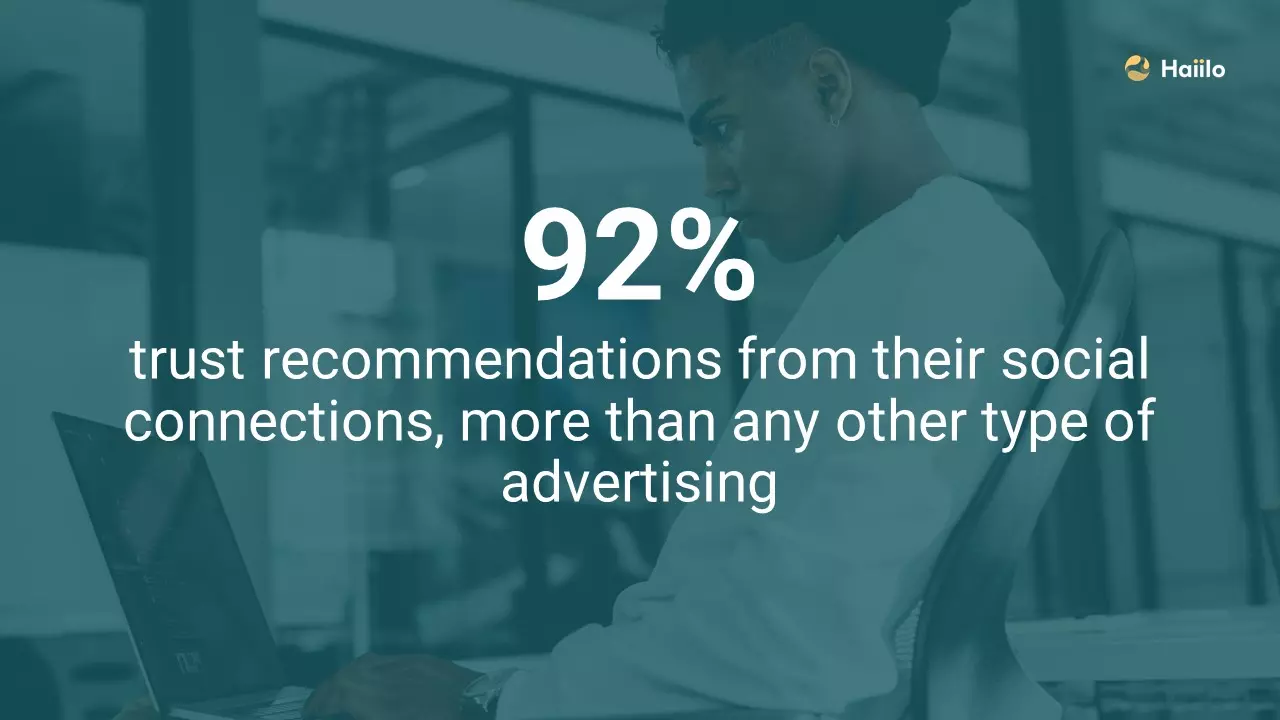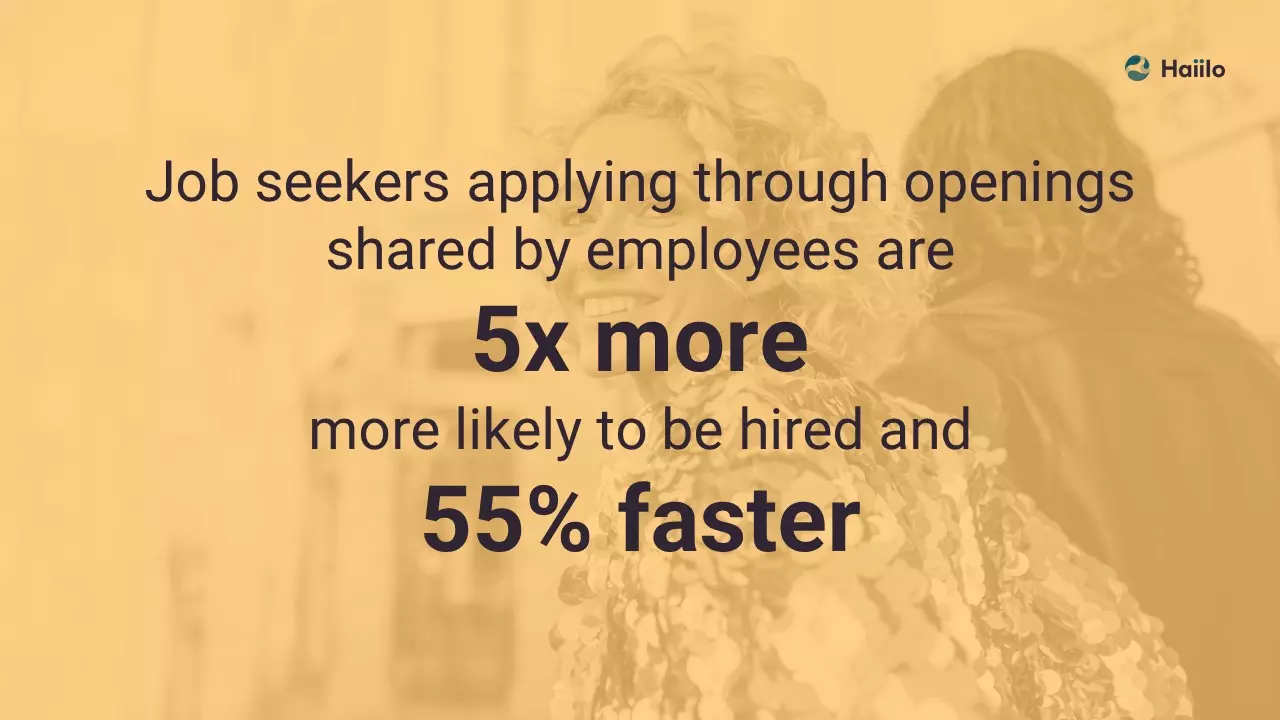Over the last 10-15 years, we’ve witnessed an exponential increase in the number of companies investing in their brands’ employee advocacy strategies, with social media being the primary driver of those initiatives.
There are limitless benefits to including employee advocacy in your company’s strategy, from brand awareness and thought leadership to lead generation, employee engagement, and much more. And while we provide a synapse of some of those reasons below, we also have many tips and tricks on the blog section of Haiilo.com.
Employee Advocacy Success on Social is in the Numbers
Take a look at some of these proven metrics, and the reasons behind corporations and other organizations having an employee advocacy strategy become clear.
Reach
Investing in employee advocacy increases the reach potential of your brand on social media channels. Employee-shared content sees eight times more engagement and is shared 25 times more frequently than identical posts shared by official social media profiles of corporations. This has meant social media posts shared by employees have an astounding 561% further reach.
Trust
Numbers show that 92% of people are more likely to trust suggestions and recommendations from those they know than any advertising will do. Giving your brand’s content a face and an authentic human emotion on your employees’ social media channels will involve your workers in your employee advocacy strategy.

Savings
A shared piece of content by an employee to Facebook or LinkedIn costs a fraction of the price of what your company would spend in paid ads. These savings include recruiting costs savings, which are substantially less through organic referrals. How does 1/10 of the price sound?
Engagement
Make your employees more motivated because that’s exactly what 85% of employees are when they’re kept abreast with the latest updates around the companies that employ them. This motivation means not only are employees more likely to stay for longer, but they’ll be more competitive and will feel more optimistic about the future of the brand.
💡 Related: The New Guide for Driving Employee Engagement in the Workplace
Recruiting
Job postings shared by your employees typically see a much more favorable result. Employee-shared job openings get more attention on social media. New candidates that come from referrals are five times more likely to be hired. And 55% faster!
Sales
Without selling your business’s products or services, it won’t be easy to see success. That’s why your employee-shared marketing leads on social media convert upwards of seven times more frequently than from other leads. Ensuring your sales team is on board, your employee advocacy initiatives can help tremendously because numbers show that sales experts are outselling their competition by 78% when leveraging social media, with recommendations resulting in 2 times the sales compared to ads.
📹 Also, take a look at our online session: Building Your Brand Through Employees: The Salesforce Way
Employee Advocacy on Social Media Done Right with these 5 Easy Steps.
Step 1. Define your Goals and Objectives
Bring your employee advocacy program into focus by ensuring your goals and objectives are appropriately defined. When shared on social platforms, attracting new business prospects and recruiting new talent are typically the main goals of an employee advocacy program. Still, you can also look to accomplish several other more specific objectives, including:
- Increasing your social engagement percentages
- Increasing traffic to your company’s website
- Hiring a set number of new hires each quarter
- Generating new sales leads and prospects
- Reeling in new followers to your LinkedIn company channel
Specific targets like these will help get and keep the buy-in from your employee advocates while allowing them to see the employee advocacy program’s clear benefits.
In conclusion, you’ll want to set tangible and reachable goals and consider how you’ll track them. In addition, you should distinguish your KPIs for marketing goals vs. talent goals. Don’t put them in the same bucket.

Step 2. Communicate and Promote
Open communication is a key to success out of any employee advocacy program. Get everyone on board, or else you won’t reap the rewards of genuine employee participation. And to get that buy-in, ensure all involved in your employee advocacy program understand what they’re expected to do. That expectation includes building those responsibilities into their busy schedules and why the company is participating in the program.
Seek out opportunities to pre-promote your employee advocacy program both through internal social channels and external channels. This can be through newsletters and social media, through Slack or Microsoft Teams, and Yammer.
Consider using your organization’s leaders to help with promoting through emails, town halls, weekly meetings, and company updates. Here they have an opportunity to express their excitement as leaders and what’s in it for both the company and for fellow employees.
When it comes to launching your employee advocacy program, it’s always a good idea to try and do so around some special event. The event can be either an external or internal event, but doing so helps to round up the troops and get everyone on board for a common theme.
Step 3. Get Buy-in from Executives
As we started getting at in Step 2, your leadership should be on board with your employee advocacy program, making sure that they are visible. Even before going live with your program, your leaders (and especially C-level leaders) should have a voice that’s trickling down through the company about the importance of employee advocacy with their social networks to help.
Consider looking at ready examples of existing leaders who are already genuinely engaging with employee advocacy naturally and use them as models and, in essence, advocates of your employee advocacy program to be worth following. This “follow-the-leader” approach typically leads to proven results.
If any of your C-level leaders are up to doing so, we propose asking them to work with you to create a welcome video, which can be used as a launching board into the platform. This video could be used for existing employees about the dive into your employee advocacy program, in addition to an onboarding piece of content for new hires into our company.
While you may have one or two executives who are already shining stars and model employees for employee advocacy, don’t forget to also involve other leaders from a range of different business units to make sure you are connecting your employee advocacy program throughout the company.
Step 4. Compile Content Contributors
As you may know, the Haiilo platform provides you with relevant content based on your location, role within the company, language and other parameters. By providing easy access to the content, you ensure a greater level of engagement with it. As a result, your employees will add a human touch to the content by engaging with it on their respective social media profiles.
💡 Also, check out Top 7 Employee Advocacy Platforms: How to Choose the Best One for You
When employees are empowered to create their own content, the result is generally a more successful employee advocacy program. Because in doing so, they’re able to bring in their expertise, a range of different topics, their personalities and more. Even better is that this content is all generally aligned with your customers already. After all, your employees are the experts in their areas of your business, so aren’t they the ones best to determine what kind of content their peers will want to read, engage with and share themselves?
When assembling your content contributors, consider employees who are already active on social media, and be sure to put those in a position to help not only curate content but help with leading the content for their areas. It’s just as important to select those colleagues who have expertise in their specific area of work.
With the content types you’ll be promoting in your employee advocacy program, it’s best to have a mix of informational and promotional content. In addition, make sure to include your internal content and use external sources for content — for example, a news story or opinion piece around a particular area of your company’s industry.

Step 5. Advocate on SoMe without Force
It’s true that some companies indeed make it a requirement for their employees to participate in their employee advocacy program and do so with force, putting it down as a necessary bullet point in their job descriptions.
We don’t recommend ever forcing employees to post on their social channels if they aren’t genuinely interested in participating.
While you may get some initial engagements and brand awareness around your company, this is not at all inspiring for those employees or their colleagues who have a genuine interest in your employee advocacy program.
Employee advocacy is something employees need to want to do. They should have a passion for the company they are working for and what they are experts in. Provide them with the tools, keep them informed and let the rest take care of themselves. If you have employees who aren’t participating, let that be okay. Not everyone needs to be on social media. Respect that and look to other employees and even new hires who would like to take the reins of playing a part and advocating for the company they’re passionate about.
There you have it.
Remember, peers in your industry are more likely to be influenced by their peers and others, so it’s always good to put a personal and human touch to shared content on your brand’s social media pages.
With the right employee advocacy system in place, your company will be generating social engagements and conversations regularly, helping to support your overall brand as a force in your industry.
Want to learn more about how other companies are using Haiilo for their employee advocacy initiatives? Schedule a demo today!









